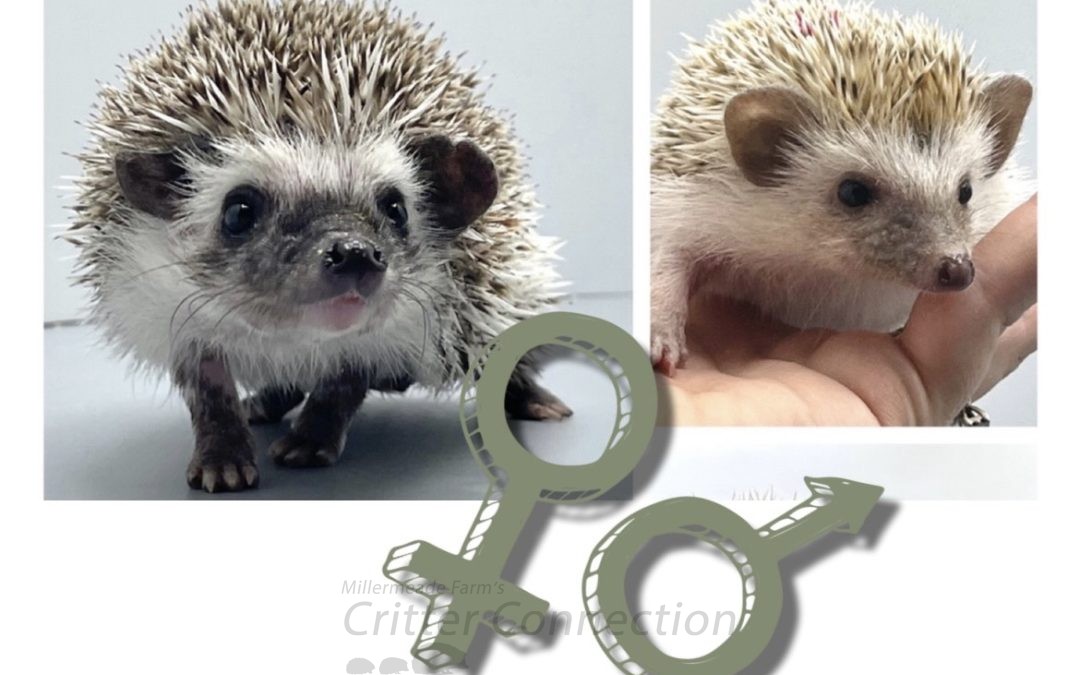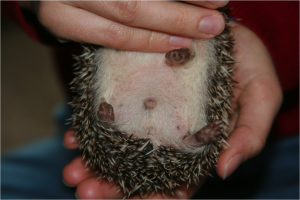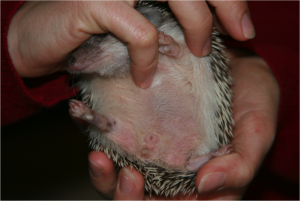Last Updated on August 25, 2022.
Physical Gender Differences
- A male hedgehog is called a boar. His penis retracts within a penile sheath located in the middle of his abdomen. The external portion of the sheath most closely resembles a belly button. His testicles are located in the abdomen and are generally not seen.
- A female hedgehog is called a sow, and her vulva and anus are very close to each other. She has five pairs of mammae, or teats.
- Male and female hedgehogs should be housed separately from the time of weaning and should only be allowed contact for breeding purposes.
- Hedgehogs can breed as early as eight weeks. Breeding at this age can be very dangerous for the female, and most breeders highly discourage it.
- There are no odor differences between males and females.
- Neither males nor females mark their scents.
- Females do not have obvious menstrual cycles.
Gender Differences in Temperament
- We at Millermeade Farms, along with a majority of hedgehog owners and breeders, do not believe major temperament differences exist between males and females.
- Males can self-stimulate, but people who own male hedgehogs don’t typically complain about this practice.
Cohabitation and Gender Differences
- It is common knowledge that hedgehogs are solitary creatures in the wild.
- However, we have found through our own experience, research, and customer feedback that some hedgehogs actually do quite well together.
- Baby hedgehogs, especially females, cohabit quite well.
- Female hedgehogs have a tendency to cohabit better than males because they do not have the testosterone hormone and hence are not aggressive during their sexually active periods. Some of our female hedgehogs prefer to have cage mates, but it is not absolutely necessary in most cases.
- Males raised together who are never exposed to females may also cohabit nicely.
- All cohabitation should be monitored throughout your hedgehogs’ lives. You should be prepared to separate the hedgehogs if signs of dominance develop. Adult males not raised together and/or exposed to females are at the greatest risk for fighting and are not recommended for cohabitation.
- Please refer to our article Are Hedgehogs Solitary or Social? for more information on this topic.
Gender Differences and Health Care
Males
- Male and female hedgehogs obviously have different reproductive and urinary tract systems, and their main health-care concerns are related to these differences.
- A male’s penis is contained in the penile sheath and is only exposed during urination, breeding, and occasionally during self-stimulation.
- Hedgehogs have low profiles and therefore their extended penises are even closer to the ground. This means that bedding can stick to an extended penis and be drawn up into the penile sheath.
- This causes irritation to the hedgehog as well as being a potential cause of infection or other damage.
- Good bedding choices and daily monitoring of your hedgehog dramatically reduces the incidence of serious problems.
- The first signs of irritation are redness and/or swelling. A bath and gentle cleansing of the area may be a sufficient treatment to remove any foreign matter.
- Veterinary care may be required for more serious irritations.
Females
- A female hedgehog’s urinary and reproductive problems appear to be closely related.
- In females, proximity to the ground may contribute to urinary tract and reproductive infections.
- One obvious indication of a urinary tract infection is visible blood in the stool. Changes in eating and elimination habits and a general decline in health are also potential signs of a problem.
- Female hedgehogs are induced ovulators, which means that the presence of males stimulate their reproductive cycles, unlike humans who are cyclic ovulators.
- Some hedgehog owners and breeders believe that having a male and female in the same household without breeding increases the risk of uterine cancers in the females.
- On the other hand, breeding also increases the risk of problems due to pregnancy, birth, and postnatal care.
- Some veterinarians recommend preventative spaying of females. However, every invasive procedure and the use of anesthesia carry risks. Proactive spaying is not yet widespread among owners of female hedgehogs, and not all vets recommend it.
- At this point, no conclusive studies show the advantages and disadvantages of preventative spaying. Since veterinarians tend to check only hedgehogs with problems, it is difficult to get a fair idea of the percentage of female hedgehogs in the general pet population in need of spaying.
- Most veterinarians and breeders DO recommend spaying at the first sign of urinary or reproductive infections. It is much easier to treat a small problem than to try to fix a larger one later on.
- We suggest finding an experienced veterinarian in your area who is knowledgeable about exotic pet care and consulting with him or her if you have any concerns about owning a female. Having a good relationship with a veterinarian is not only beneficial before buying your pet and for routine care, but will be critical when dealing with a pet that needs emergency care.
Gender Considerations When Purchasing Your Hedgehog
- Most hedgehog breeders and enthusiasts encourage new pet owners to be very cautious when buying a female hedgehog that has been housed with a male past six weeks of age.
- You may be surprised if your baby female has been with a male, even if that male was a littermate. It is rare for hedgehogs to reproduce at six weeks, but even experienced breeders encounter accidental breeding between siblings.
- It is always a good idea to ask your breeder to show you how to check the gender of your baby or be prepared to check it yourself. Even knowledgeable breeders can get their babies mixed up or make a simple mistake.
- Always be prepared to separate babies when buying two. Two female hedgehogs can often cohabit beautifully and may even prefer companionship, but there is always a risk that one can become detrimentally dominant over the other.
- Two male hedgehogs have a tendency to express dominance especially when they go through adolescence or if a female is present. It is always a good idea to prepare for separation even though male cohabitation can work.
- NEVER house male and females together past the age of six weeks.
Conclusion
- It is our experience that neither males nor females make better pets.
- On many occasions, potential hedgehog owners decide that their family might enjoy TWO hedgehogs instead of ONE.
- Two females tend to cohabit better than males, so if your family might possibly end up with two hedgehogs, we suggest making your first a female.
Primary Author: Gail Smith, Millermeade Farm’s Critter Connection
Contributor: Susan Crocker, Susan’s Hawkeye Hedgies, Melissa Ramos








